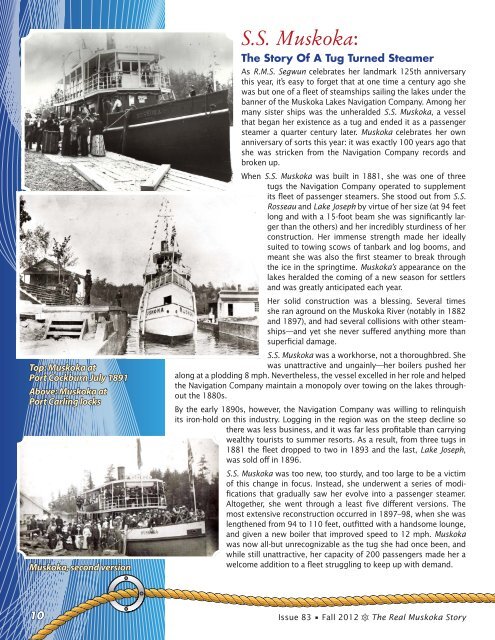STORY STORY - Real Muskoka
STORY STORY - Real Muskoka
STORY STORY - Real Muskoka
Create successful ePaper yourself
Turn your PDF publications into a flip-book with our unique Google optimized e-Paper software.
Top: <strong>Muskoka</strong> at<br />
Port Cockburn July 1891<br />
Above: <strong>Muskoka</strong> at<br />
Port Carling locks<br />
<strong>Muskoka</strong>, second version<br />
S.S. <strong>Muskoka</strong>:<br />
the Story of a tug turned Steamer<br />
As R .M .S . Segwun celebrates her landmark 125th anniversary<br />
this year, it’s easy to forget that at one time a century ago she<br />
was but one of a fleet of steamships sailing the lakes under the<br />
banner of the <strong>Muskoka</strong> Lakes Navigation Company. Among her<br />
many sister ships was the unheralded S .S . <strong>Muskoka</strong>, a vessel<br />
that began her existence as a tug and ended it as a passenger<br />
steamer a quarter century later. <strong>Muskoka</strong> celebrates her own<br />
anniversary of sorts this year: it was exactly 100 years ago that<br />
she was stricken from the Navigation Company records and<br />
broken up.<br />
When S .S . <strong>Muskoka</strong> was built in 1881, she was one of three<br />
tugs the Navigation Company operated to supplement<br />
its fleet of passenger steamers. She stood out from S .S .<br />
Rosseau and Lake Joseph by virtue of her size (at 94 feet<br />
long and with a 15-foot beam she was significantly larger<br />
than the others) and her incredibly sturdiness of her<br />
construction. Her immense strength made her ideally<br />
suited to towing scows of tanbark and log booms, and<br />
meant she was also the first steamer to break through<br />
the ice in the springtime. <strong>Muskoka</strong>’s appearance on the<br />
lakes heralded the coming of a new season for settlers<br />
and was greatly anticipated each year.<br />
Her solid construction was a blessing. Several times<br />
she ran aground on the <strong>Muskoka</strong> River (notably in 1882<br />
and 1897), and had several collisions with other steamships—and<br />
yet she never suffered anything more than<br />
superficial damage.<br />
S .S . <strong>Muskoka</strong> was a workhorse, not a thoroughbred. She<br />
was unattractive and ungainly—her boilers pushed her<br />
along at a plodding 8 mph. Nevertheless, the vessel excelled in her role and helped<br />
the Navigation Company maintain a monopoly over towing on the lakes throughout<br />
the 1880s.<br />
By the early 1890s, however, the Navigation Company was willing to relinquish<br />
its iron-hold on this industry. Logging in the region was on the steep decline so<br />
there was less business, and it was far less profitable than carrying<br />
wealthy tourists to summer resorts. As a result, from three tugs in<br />
1881 the fleet dropped to two in 1893 and the last, Lake Joseph,<br />
was sold off in 1896.<br />
S .S . <strong>Muskoka</strong> was too new, too sturdy, and too large to be a victim<br />
of this change in focus. Instead, she underwent a series of modifications<br />
that gradually saw her evolve into a passenger steamer.<br />
Altogether, she went through a least five different versions. The<br />
most extensive reconstruction occurred in 1897–98, when she was<br />
lengthened from 94 to 110 feet, outfitted with a handsome lounge,<br />
and given a new boiler that improved speed to 12 mph. <strong>Muskoka</strong><br />
was now all-but unrecognizable as the tug she had once been, and<br />
while still unattractive, her capacity of 200 passengers made her a<br />
welcome addition to a fleet struggling to keep up with demand.<br />
10 Issue 83 • Fall 2012 The <strong>Real</strong> <strong>Muskoka</strong> Story



